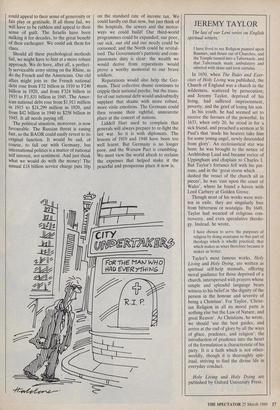JEREMY TAYLOR
The last of our Lent series on English spiritual writers.
I have lived to sec Religion painted upon Banners, and thrust out of Churches, and the Temple turned into a Tabernacle, and that Tabernacle made ambulatory and covered with skins and torn curtains. . . .
In 1650, when The Rules and Exer- cises of Holy Living was published, the Church of England was a church in the wilderness, scattered by persecution; and Jeremy Taylor, deprived of his living, had suffered imprisonment, poverty, and the grief of losing his son.
In his youth, he had seemed set to receive the favours of the powerful. In 1633, when only 20, he stood in for a sick friend, and preached a sermon at St Paul's that 'made his hearers take him for some young angel, newly descended from glory'. An ecclesiastical star was born: he was brought to the notice of Archbishop Laud and became rector of Uppingham and chaplain to Charles I. But Taylor's fortunes fell with his pat- rons; and in the 'great storm which . . . dashed the vessel of the church all in pieces', he was 'cast upon the coast of Wales', where he found a haven with Lord Carbery at Golden Grove.
Though most of his works were writ- ten in exile, they are singularly free from bitterness or nostalgia. By 1649, Taylor had wearied of religious con- troversy, and even speculative theolo- gy. Instead, he wrote, I have chosen to serve the purposes of religion by doing assistance to that part of theology which is wholly practical; that which makes us wiser therefore because it makes us better.
Taylor's most famous works, Holy Living and Holy Dying, are written as spiritual self-help manuals, offering moral guidance for those deprived of a church, interspersed with prayers whose simple and splendid language bears witness to his belief in 'the dignity of the person in the honour and severity of being a Christian'. For Taylor, 'Christ- ian Religion in all its moral parts is nothing else but the Law of Nature, and great Reason'. As Christians, he wrote, we should 'use the best guides, and arrive at the end of glory by all the ways of grace, prudence, and religion': the introduction of prudence into the heart of the formulation is characteristic of his piety. It is a faith which is not other- worldly, though it is thoroughly spir- itual, striving to find the divine life in everyday conduct.
Holy Living and Holy Dying are published by Oxford University Press.


















































 Previous page
Previous page